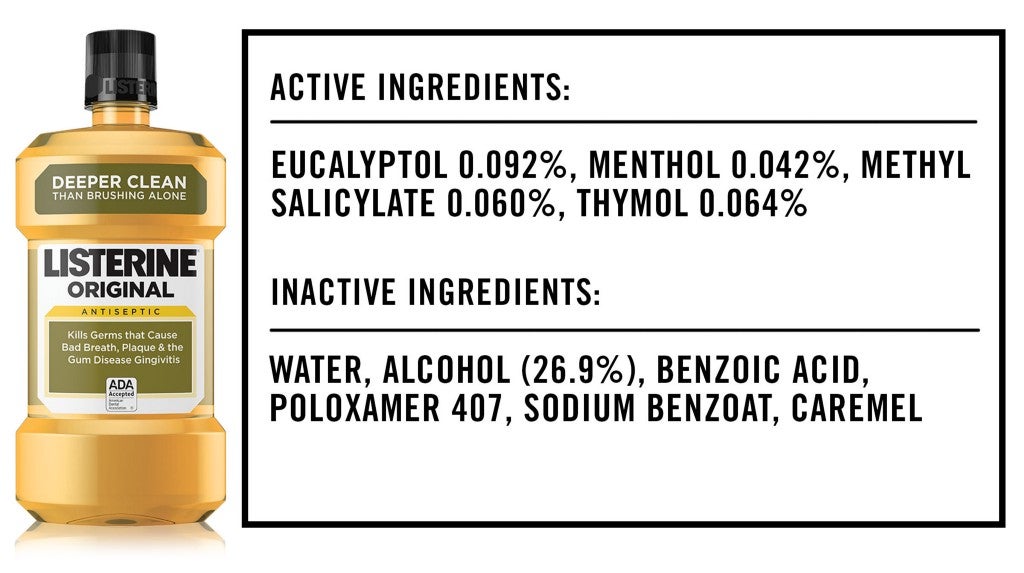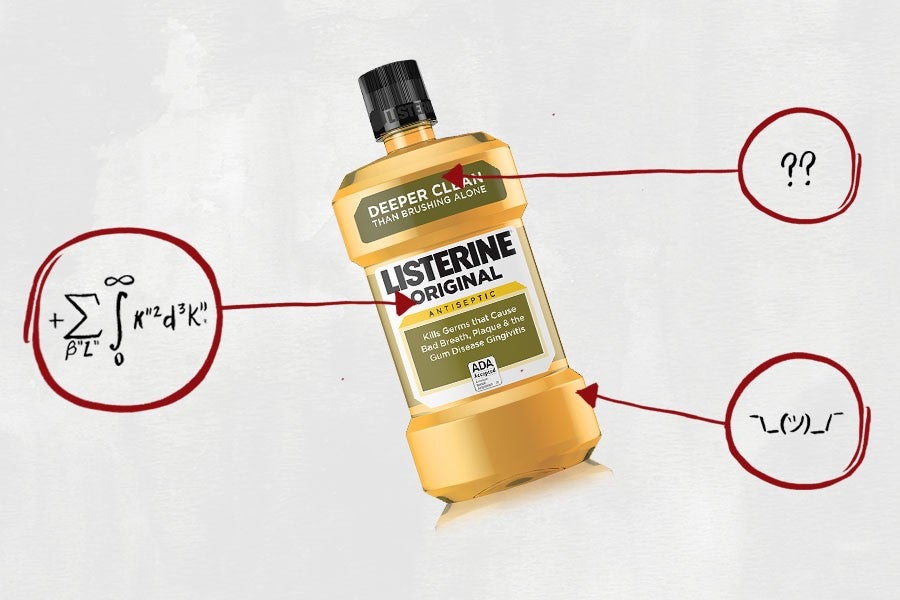We’re often told that you should never eat anything (or put anything on your body) if you don’t recognize everything on the ingredients list. But since most of us have no idea what xanthan gum or potassium benzoate are — or more importantly, what they’re doing to our bodies — we’re decoding the ingredients in the many things Americans put in (and on) themselves with the help of an expert.
This edition: Listerine Original Antiseptic Mouthwash, which is made from 10 separate ingredients that we’ve broken down in the exact order they appear on their website.

The Ingredients
1) Eucalyptol: “Eucalyptol is a colorless oil predominantly found in eucalyptus that’s often used as a flavouring or fragrance agent,” explains Dagan Xavier, ingredient expert and co-founder of Label Insight. “It can also act as an antibacterial and antifungal agent.” In this case, it helps to reduce plaque buildup.
2) Menthol: Sourced primarily from peppermint, menthol has astringent and antibacterial properties that inhibit bacterial growth and reduce plaque buildup. It also helps treat bad breath.
3) Methyl Salicylate: Also known as wintergreen oil, methyl salicylate has anti-inflammatory properties. It’s also the culprit behind that cool-but-warm wintergreen tingle you feel when gargling mouthwash.
4) Thymol: Thymol is a component of thyme oil with antibacterial and antifungal properties, which is why it’s often found in mouthwash — to fight tooth decay and eliminate bad breath.
5) Water: This acts as a base for the other ingredients.
6) Alcohol: Alcohol primarily acts as a carrier agent for menthol, eucalyptol and thymol (it also provides a satisfying burn and bite). But the truth is, you’re better off opting for alcohol-free mouthwash: A recent study suggests excessive use of mouthwash containing high amounts of alcohol may increase your risk of developing oral cancer. That’s because alcohol is carcinogenic, and unlike beer and wine, mouthwash requires swishing for 30 to 60 seconds at a time, which allows the alcohol to seep deep into the mouth tissues.
Worse yet, alcohol also reduces the effectiveness of mouthwash. That’s because alcohol dries out the mouth, and a dry mouth doesn’t allow bacteria to be flushed out. And when bacteria build-up in the oral cavity, they produce bad breath.
7) Benzoic Acid: “Benzoic acid most commonly functions as a preservative in foods and cosmetics,” Xavier explains. “It can also be used to add fragrance to a product.” But be warned: Various studies have found that benzoic acid is poisonous in large doses, so, y’know, don’t drink mouthwash.
8) Poloxamer 407: “This functions as an emulsifier to promote and/or maintain the mixture of unblendable liquids,” Xavier explains. While it may sound unnatural — and therefore, dangerous — a safety assessment published in the International Journal of Toxicology found no evidence to suggest poloxamer 407 is unsafe for use in cosmetic products.
9) Sodium Benzoate: Acting as yet another preservative, studies show that sodium benzoate may exacerbate hyperactive behavior in young children, so we’ll warn you again (even though we shouldn’t have to): Don’t let your children drink mouthwash!
10) Caramel: This refers to coloring, and as we discovered in our exploration of the eight ingredients that make up Diet Coke, caramel coloring has an incredibly controversial byproduct called 4-methylimidazole (4-MEI): A 2007 study found that mice fed a diet of 4-MEI developed cancerous lung tumors as a result. The FDA quickly pushed back, noting that a human would have to consume more than 1,000 cans of soft drinks (which are notoriously high in caramel coloring) every day for two years to reach comparable levels of 4-MEI.
Who’s right is still unclear. More recent studies argue that levels of 4-MEI are, in fact, high enough in soda and consumed in sufficient quantities by Americans to increase the risk of developing cancer. Do you really have to worry about this in your small swish of mouthwash, though? Probably not.
The Takeaway
Listerine Original Antiseptic Mouthwash doesn’t contain many “red-flag” ingredients — so long as you don’t drink it, that is. However, because it contains alcohol, this mouthwash may not do a great job of reducing bad breath (which is sort of the entire point of mouthwash). For that, we recommend alcohol-free mouthwash.

